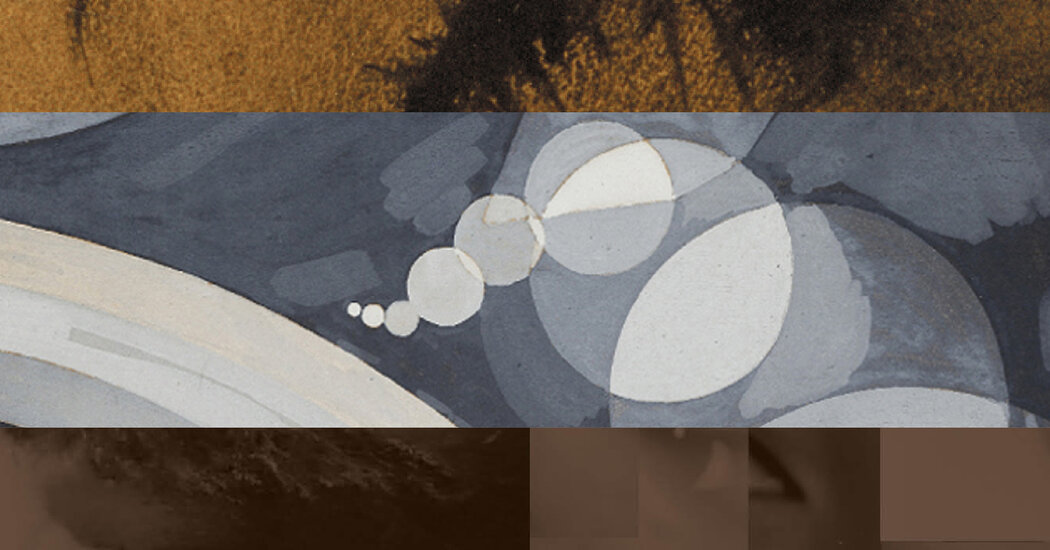‘American Counterpoints’
Experiential Orchestra; James Blachly, conductor; Curtis Stewart, violin (Bright Shiny Things)
Julia Perry, who would have turned 100 this month, achieved some real recognition during her lifetime, but — in a tale all too common for composers who aren’t white men — fell into obscurity after her death in 1979. There have been recent efforts to revive her works, including her Violin Concerto, written in the 1960s and now recorded by the Experiential Orchestra under James Blachly, with Curtis Stewart as the soloist.
This brooding, 25-minute piece begins with a passionate violin cadenza, played like the rest of the concerto with heated commitment from Stewart, and then evolves frequently, without defined section breaks. It is a fine example of the sober yet seething angularity of its era, leavened with warm strings and hints of Coplandesque expansiveness.
It’s a vigorous work of mid-20th-century Neo-Classicism, and has fine company on the album in another: Coleridge-Taylor Perkinson’s Sinfonietta No. 1, with a wrenching slow movement and a driving finale. The recording also includes Perkinson’s violin solo “Louisiana Blues Strut,” lively in the performance by Stewart, whose raucous, hip-hop-influenced “We Who Seek” appears as well. And there is more Perry: the lushly contemplative Prelude for Strings, the alternately assertive and hovering Symphony in One Movement for Violas and Basses and the hymn “Ye, Who Seek the Truth,” in an instrumental arrangement by Jannina Norpoth. ZACHARY WOOLFE
When Aaron Copland died in 1990, Allan Kozinn wrote in The New York Times, “Composers’ performances are not always definitive, but Copland was a fine, communicative conductor and pianist.” That assessment is amply borne out by this 20-CD box set of the composer’s recordings of his own oeuvre for Columbia Records.
Somewhat surprisingly, Copland shows himself less convincing in populist works like “Appalachian Spring” and “Rodeo,” pieces in which others have brought out the music’s rhythmic snap more adroitly. Where he excels on the podium is in brawnier fare, such as “Music for a Great City,” “Statements” and “Symphonic Ode,” reminding a listener how sharp-elbowed his orchestral writing could be. He was also a superb pianist and accompanist, as heard in recordings of the Sonata for Violin and Piano (with Isaac Stern); the Piano Quartet (with members of the Juilliard String Quartet); and various song cycles. Benny Goodman’s two accounts of the Clarinet Concerto will remain classics as long as this music is cherished.
Perhaps most revealing in this set are clips from Copland’s rehearsals for the chamber version of “Appalachian Spring.” More than once, he warns the musicians that their playing is verging too close to straight sentiment. “The sound’s on the Tchaikovsky side,” he says at one point. “Make it more American spirit […] more cool. The music by itself is warm — you don’t have to help it.” Conductors should heed his advice. DAVID WEININGER
‘Wide As Heaven: A Century of Song by Black American Composers’
James Martin, baritone; Lynn Raley, piano (New World)
The New World label is committed to Black American classical repertoire, with releases including a period-orchestra version of Scott Joplin’s opera “Treemonisha,” the “Black Manhattan” series and Anthony Davis’s more contemporary “Amistad.”
This varied, moving and entertaining album extends that tradition, with pieces by Davis, William Grant Still and many others — and with powerful performances by the baritone James Martin and the pianist Lynn Raley. Take Harry T. Burleigh’s magnificent setting of the Whitman poem “Ethiopia Saluting the Colors”: Here, Martin is robust and convincing when voicing both a Union Army soldier and an older, enslaved woman who is saluting the American flag.
But where the baritone Thomas Hampson has, in the past, smoothly navigated the repetition of “sunder’d” during the woman’s story, Martin allows a slight, vulnerable tremor to enter into his second pass at the word. At the piano, Raley’s crisp attack maximizes the piece’s occasionally chromatic approach to military gait. And that’s just one of the fine items here. Hall Johnson’s “On the Dusty Road” has marvelous blues feeling; Davis’s “Bells” rings with echoes of bebop and gamelan during its take on art song. And the boogie-woogie piano elements of Margaret Bonds’s “The Way We Dance in Harlem” inspires rousing vocalizations from Martin. SETH COLTER WALLS
Duruflé: Requiem; Poulenc: Lenten Motets
Choir of Trinity College, Cambridge; Harrison Cole, organ; Stephen Layton, conductor (Hyperion)
Note for note, Maurice Duruflé’s Requiem is an astoundingly pretty work that critics have described as “a luxuriant harmonic bath” and “an impressionist’s large-scale plainsong fantasy.” Trained as an organist and steeped in the melodic mysticism of Gregorian chant, Duruflé deployed plainsong with a naturalness and harmonic sophistication that sound anachronistic for the mid-20th century, but also sound eternal.
The Choir of Trinity College, Cambridge, dials up the plushness with the 1948 version for organ, and the instrument at Saint-Eustache in Paris is so sonorous and pillowy as to render an orchestra wholly unnecessary. The organist Harrison Cole swathes the sumptuous choruses in downy comfort. Chords and busy 16th-note runs drift by like clouds. Even harmonic abrasions have a smooth-edged refinement.
Stephen Layton’s baton keeps the music flowing, all lush and heady, and the Trinity singers, treating consonants as mere suggestions, string together syllables into a liquid legato. Vaporous strands float from the soprano section, and the altos and basses are warmly anchoring yet improbably diaphanous. The tenors’ bright cast occasionally pierces the mood, and the vocal soloists inject welcome verve and personality amid the ensemble’s anonymous gorgeousness.
An incisive rendition of Poulenc’s Four Lenten Motets for a cappella chorus closes the album in a display of versatility, but the Requiem’s final movement, “In Paradisum,” provides the true resolution. The richly arrayed divisi singing, solid yet transparent, dissolves into the organ’s final chord, an elegant metaphor for apotheosis. OUSSAMA ZAHR
Bruckner: Symphony No. 7
Bavarian Radio Symphony Orchestra; Bernard Haitink, conductor (BR Klassik)
Does the world really need another recording of Bruckner’s Seventh Symphony by Bernard Haitink? That’s a reasonable question: Bruckner’s symphonies were central to the eminent conductor’s repertoire, especially the Seventh, the work with which he bid farewell to his musical career, in 2019. At least five other commercial recordings were available before the release of this 1981 live performance. It takes little searching to find more.
Still, I found this new entry impossible to resist. Haitink was a master at pacing large symphonic structures with impeccable, understated eloquence. Few pieces reward this skill like Bruckner’s Seventh, and here he shapes with just enough momentum to propel the vast opening movements onward without sacrificing the music’s sonic splendor. The Bavarian Radio Symphony Orchestra plays with a refinement that’s expected, and a transparency that surprises. The ensemble’s brasses are appropriately potent at the work’s many apexes, but they impress even more when the score calls for delicacy and restraint.
Bruckner front-loads so much in the first two movements that the other half of the symphony can feel like an afterthought. One additional virtue of this account is that Haitink makes the mazelike finale spring with energy, charm and a constant sense of wonder. DAVID WEININGER

